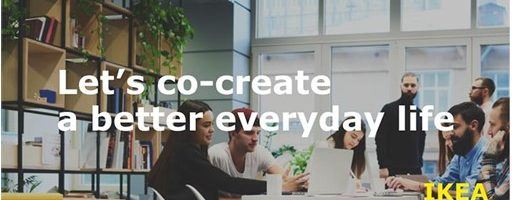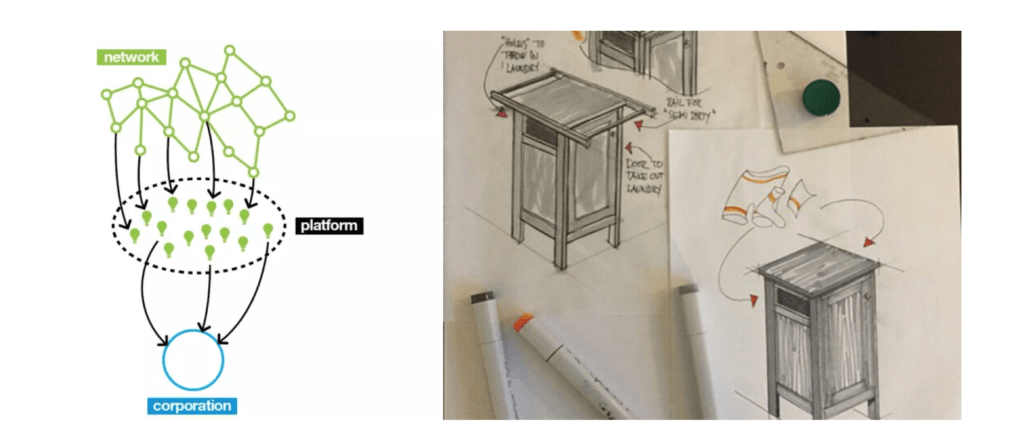IKEA: crowdsourcing ideas to co-create a better everyday life

IKEA, the traditional furniture retailer with 75 years history, is now planning a digital platform to co-create products and innovations with third-party designers, startups, and customers.
“We are launching ‘Co-Create IKEA’, a digital platform where customers will have the possibility to develop and test new products … a bit like the open-source development within IT,” Torbjörn Lööf, chief executive of Inter Ikea, said.
How will it work?
The “co-create IKEA” platform will be looking into five areas: product ideas, Bootcamp, collaborating with university students, and connecting with innovation labs and makerspaces around the world.
The platform of “Product ideas” will soon be launched and it will be a place for everyone who has a passion for furniture design and who wants to turn daily needs or frustrations into solutions to take part in the development and testing of new products. IKEA hasn’t disclosed many details but a product they just launched in early 2018 might be helpful for us to imagine how will the co-creation work – Delaktif is an “open source” sofa launched recently, and IKEA opens the door for customers to experiment their ideas, allowing third-party designers, manufacturers, or anyone, to create complementary products that can attach to the sofa or modify its use (see picture below).
“Bootcamp” is a platform opens up for curious and motivated startups to solve IKEA’s big problems. In 2017, IKEA launched its first Bootcamp, 1200 teams submitted their applications online and 10 selected projects, from smart home system to bicycle trailers, will be working with IKEA design team in IKEA Design center for 3 months. IKEA may license their technology or product, or be an investor in the future.
Value creation and value capture:
For participants, from consumers, third-party designers, to startups, they all have strong incentives to participate:
- Like the case of Threadless and Tongal, these participants appreciate the opportunity to work with IKEA on product innovation. IKEA is the world’s largest furniture retailer, and designing a product for IKEA will be a social proof or help the career development for these participants.
- Participants can get the reward. Participants will get money if their ideas work. In addition to that, IKEA provide many resources, like test labs, prototype shop and knowledge, to help selected participants create their products/ideas.
- Participants have strong Intrinsic motivations to do so. IKEA has long inspired a “hacker community” where people are passionate about modifying IKEA furniture and share their ideas. For example, https://www.ikeahackers.net/ is a website for hackers share their ideas and was built by IKEA fans. I think we can foresee that many people, including these hackers, will have incentives to participate because they just enjoy doing it, making their ideas happen and sharing great ideas with others in the community.
For IKEA, it can leverage the wisdom of the crowd in product innovation, and this can benefit the company in a few ways:
- Involving customers in design can help IKEA get more customer insights and build customized and better products. As Mr.Dixon, the designer of the open-source sofa said “there might be things that we can’t think of that people might want to add.”
- The creative ideas from the crowd can help IKEA on their continuous innovations and achieve their mission of proving affordable, accessible and environmental-friendly products for more customers.
- Involving customers in the design can actually enhance customer satisfaction and help build deeper and sticker relationships with customers.
- Crowdsourcing ideas can help IKEA save some R&D cost and monetize on ideas and products contributed by the crowd.
Challenges:
Like other traditional retailers, IKEA was actually slow in migrating to digital. I am wondering whether IKEA can have the digital expertise and capability to build their “co-create IKEA” an effective digital platform to connect and manage the participants around the world and whether the platform can continuously offer enough challenges to motivate people to participate over time. Since this is a new initiative of IKEA, I am looking forward to seeing what will happen and how will it impact my experience as an IKEA customer.
Sources:
- https://co-createikea.com
- https://www.reuters.com/article/us-ikea-sales/ikea-plans-full-range-town-center-showrooms-open-source-design-idUSKBN1CE1HK
- https://newsroom.inter.ikea.com/news/ten-startups-will-co-create-the-future-with-ikea/s/03c981f9-6d6e-4655-8726-cd9307749526
- https://www.ikeahackers.net
- https://www.wsj.com/articles/ikeas-open-source-sofa-invites-customization-1485715752





Thanks for your post, Ting! When I first read it, I thought the bootcamp concept would only apply to crowdsourcing ideas for furniture, but I think it’s very interesting that IKEA is also testing on other parts of their business, such as their food store. Apparently, the concept of bug-filled meatballs and algae products comes also from bootcamp! Not sure how sustainable or scalable this model actually is, since the bootcamp finalists have to travel to Sweden and work in the implementation with them, but it’s anyway a very interesting form of sourcing new ideas.
Totally agree with @Juan. Hopefully IKEA can turn the one-off bootcamp into a recurring “fountain of creativity” for its various business verticals with a sustainable feedback loop for iterative learning. Wonderful post!
Ting, this is super interesting! I was wondering for “Product Ideas” – how big the number of furniture designers / creators there are in the world. This obviously requires a high level of expertise to engineer furniture in addition to the design creativity. I wonder if similar to Tongal, they could almost un-bundle the design / creative element and then the engineering / construction portion. Then maybe you would get more engagement from the broader creative community, such as interior designers.
I’d be curious to know more about the IP rights afforded to the participants. I worry that Ikea could lose participant trust if it is ever perceived as copying an idea (even if that idea had already been in the works by Ikea HQ).
Love the post! I was especially impressed with the Ikea hackers’ community – it shows an impressive brand loyalty and engagement and it is great that IKEA found the way to harness it! I agree with your points regarding the cost-minimization and the community satisfaction as a result of this innovation! What I think IKEA should be careful with is protecting its visual and design identity while outsourcing its designs from all over the world. This would mean setting up very clear design requirements and choosing criteria for the participants, yet not restricting the creative freedom. Outsourcing design also requires a clear agreement on the IP ownership to avoid any negative PR that can affect its reputation (we had a similar project with Absolut vodka back at Chivas Brothers and the legal context is quite tricky and requires a lot of attention).
I really like the idea. I think there is a lot of potential here. One of the main problems that companies like IKEA face as they scale is maintaining a local feel while leveraging global scale. I think this bootcamp will increase their flexibility and their responsiveness to changing trends. In addition to the IP rights, I think it’s important to consider how the ideas will be vetted to ensure the quality that is associated with IKEA. Their brand image can be damaged if they are not careful in curating only the best ideas. Thanks for sharing!
This is an excellent article. Nowadays custom furniture like walk in or built in wardrobes are very popular. These type of furniture make the life more easy.